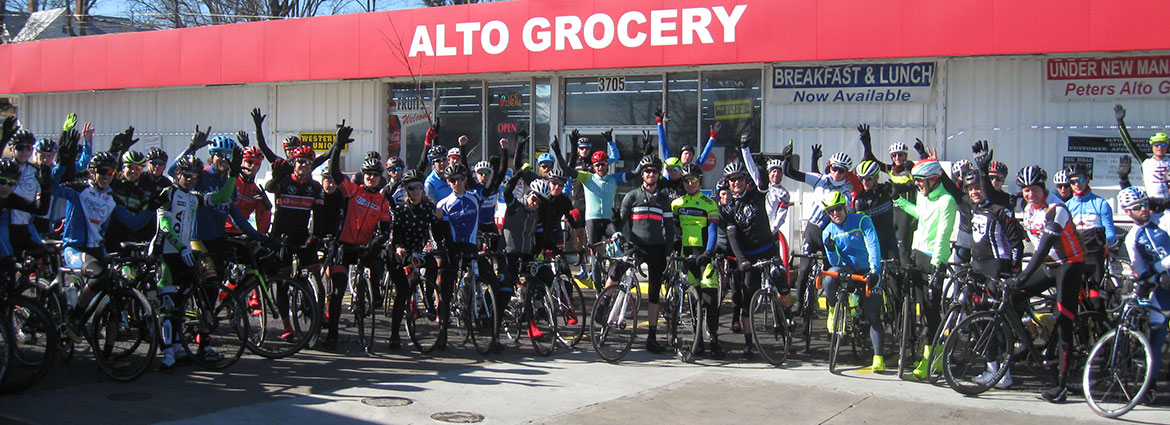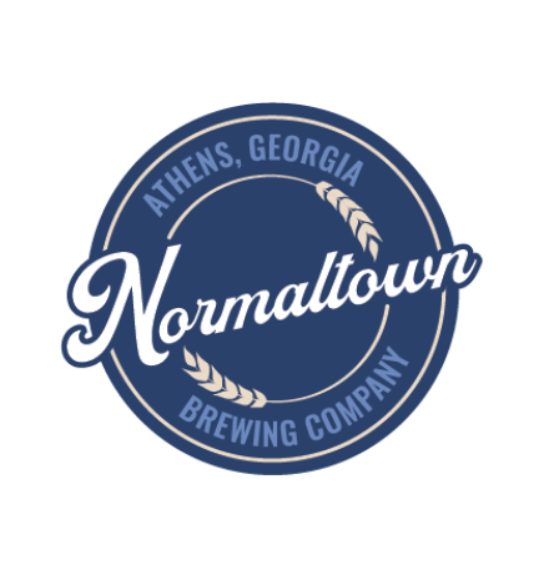Ride the Rockies 2013: The Flight of the Stork Page 2
Day 6 / Day 3 RTR: Durango to Pagosa Springs (Tuesday, June 11)
Tuesday, 11 June 2013 is date that will live in infamy for a couple of reasons. The day started like the others; we were all waking up a little earlier each morning, except Pac Man, of course. He needed an extra 5 minutes of shut eye because he’d been out late again the night before. I’m not sure what he’d been up to, Pac Man stayed mum, but his dancing shoes were caked with mud.
Every morning each of us prepped for the day in our own special way. We always camped near a facility with indoor showers and even inside camping on a gym floor. The gym floors of each facility was always packed with a hundred cyclists sprawled out on mats and sleeping bags. Many facilities, as in Durango, were local high schools equipped with showers and a cafeteria. Once I discovered all the facilities had indoor showers, I usually headed inside for my bathroom sabbatical and morning ablutions as soon as I rose.
Unfortunately, in Durango the indoor shower was a single, swinging metal hose that dangled from the ceiling in a large, tiled room. The hose dripped out a paltry, insignificant amount of water. Too add insult to injury, group showering was in vogue. I didn’t learn this last tidbit of information until I dropped my towel and headed into the shower room and was greeted by a dozen nude men who were already standing in line and waiting their turn. I grabbed my genitals with both hands and tried to look cool. Unfortunately, a dozen naked old, shaved-leg men standing around in a steamy room is more comical than cool. Still, one must try. Eventually I stood under the shower head for a few seconds and let a few droplets dribble on me. By this point my pride was vanquished so I took my time and brushed my teeth too.
Every morning the RTR staff also offered breakfast at the school cafeteria. The breakfasts weren’t dazzling, but breakfast burritos, scoops of egg, link sausage and pancakes were usually on offer. Outside in the parking lot there was also always a rolling city on wheels: vans, wagons, RVs and buses that moved everyday with the rest of the Tour. The drivers would arrange their vans and buses every day in a different way depending on the layout of the parking lot, but always in such a way as to allow easy movement through and easy access to all the various products for sale. On offer from these rolling vehicles were other edibles, hot coffee, cold drinks, and bike products of all kinds.
Most beloved of the bunch were the bike mechanics. When 2,000 cyclists come together to ride for a solid week, bike mechanics and butt butter are in high demand. My favorite mechanics were two guys who traveled from town to town in a VW van with a Wheat Ridge Cycles logo painted on the side. They’d roll in to the lot and park, sleep in their van, and wake up early and slide open the doors. Inside was a treasure trove of all sorts of bike parts, wheels, tires, screws, Allen wrenches and tubes. Each mechanic set up a bike stand outside the van and the cyclists started lining up about 5:30 each morning. The mechanics performed all sorts of bike repairs with a smile and they worked mainly for tips. My guess is that they made out well.
All five of us always went inside the facility each morning to attend to business, along with dozens and dozens of others, and met back at our tents later. Depending on the circumstances, we either headed out to a local diner for breakfast and more java or we ate in the cafeteria. The morning we woke up in Durango, the downtown area was about 2 miles away, and the road there was rough and patchy. We decided we’d eat what was available on site. I needed the mechanics to tighten my handlebars anyway, so I told the fellows I’d meet them in the parking lot out front in a bit and we could roll from there. Everyone had some matter or another to attend to before departing, so the plan suited everyone.
However, in an unusual variation from the norm, the Stork was ready to fly. “I’m heading out into the wild blue yonder,” he announced. “Yall can catch me later.” The day’s ride was 86 miles with 3,600 feet of climbing. Not to mention, the profile showed a steep 15 mile climb right out of the gate. “Yea, you go on ahead,” Ratchet chortled, “maybe you’ll stay away all day.” We all snickered. Crumley even guffawed. Pac Man slapped his knee and hammered his foot off the ground. The Stork grabbed his bike and clacked off in his cleats. I could tell he was angry by the way his carbon soles clapped off the pavement.
Thirty minutes later, after finishing at the mechanic’s stand, the rest of us rolled away. We headed out of town on a bike trail that was laid beside the Animus River, a wide, fast-flowing river that runs through downtown Durango. It was freezing again this particular morning and the fact that we were riding beside a frigid, smoking stream only increased the chill. After a couple of miles on the trail, we finally popped out onto a paved road. A few miles later, the climbing began. Finally, we could open the throttle a little in order to warm our aching bones.
Just as we were approaching the beginning of the climb, a hot shot cyclist wearing a Team Brooklyn black and white striped jersey came zipping by us with his nose in the air like he owned the damn road. Crumley told me to write the offender’s jersey name down, along with a brief description of his physiognomy, so we could deliver a beat down later. I wrote down “Asshole from Brooklyn” in my Little Black Book I keep in my jersey pocket.
The four of us set a solid tempo on the 15 mile ascent. We stayed together and motored quickly up the climb. Sure, the Stork had a few minutes on us, and though we took a long pee break halfway up, and an even longer stop at the aid station at the top of the climb, who cared? The Stork was simply not capable of holding us off. “Storks can’t fly 85 miles,” Crumley insolently bellowed, and we all laughed again. Then I remembered that gleam I’d seen in the Stork’s eyes earlier when he turned and stomped away. It was as if a wild-eyed devil was living inside him that had murder on its mind. Those two blazing eyes burned a hole in my psyche. They continue to haunt me in my dreams.
After the 15 mile climb our chase began in earnest. The course profile showed a long, gradual 35 mile descent followed by a long, gradual 35 mile climb to Pagosa Springs. On the downhill section we took turns turning the screw. We all took long pulls, 20 minutes or more, and cranked up the pace. In fact, by days’ end, we averaged 22 miles per hour, the fastest of the entire week.
Every blue moon there are those rare days that all cyclists live for. These are the days that a rider’s legs feel weightless and his (or her) body feels in perfect synchronicity with his bike. The bike is simply an extension of the person and pedaling is fluid and easy. These are the days when one can push the pace at the front for miles without tiring. These days, in many respects, represent the pinnacle not just of cycling, but life itself. Though these are the magical days we all work for, they are difficult to achieve. When a cyclist does experience one of these days, whether by precise training or random chance (as in my case), the time is like quicksilver—it’s hard to hold on to for long but the memory always lasts. This day from Durango to Pagosa Springs, for me, was one of these golden days.
The Stork didn’t have a prayer. We were gliding down the road like a fired bullet. Not only was I one with my machine, we are all clicking on all cylinders. We went zinging by others like they never existed, ripping up the blacktop and tearing down the road. We crushed the 35 mile downhill section of the ride and without stopping for refreshments, began blasting up the 35 mile climb. I was a little surprised when we hadn’t caught the Stork by the 50 mile mark, but I was hardly worried. It would be more satisfying to blow by him on the uphill and leave him singing the blues behind. Up the road, however, the Stork had other plans.
Up the road, the Stork was also sailing with gilded wings. The Stork was jumping from one group to another in an all-out blitzkrieg. He was riding shotgun at the back of one group, then attacking out of the saddle and bridging to the next group. He rested momentarily, gauging the speed of the group, and then he jumped again. In this way the Stork was rapidly advancing up the road. Though we were slowly closing the gap behind, the Stork was making a run for gold. If he pulled this off, it would cement his legacy forever. We couldn’t let that happen!
As we hit the final 10 miles of the climb and still didn’t have radar lock on Big Bird, we punched the pedal to the floorboard. We were full on the gas and climbing at 25 miles per hour. Surely the Stork could not fend off this kind of pressure. With 5 miles to go we became frantic and let loose a furious, two-wheeled assault. The shell of our cohesive group began to crack. Other riders were streaming by as we caught and passed them but there was no sign of the Stork. One by one we made last minute mad dashes up the climb, knowing Pagosa Springs was close. We were hoping to flick the others and go flying by the Stork in the closing kilometers.
But the Stork caught his second wind with 5 miles to go. He realized he was on the verge of the greatest victory in his life and he shifted into overdrive. The Stork was fighting his bike and wrestling with his frame. He grimaced with each pedal stroke and his shoulders rocked and his head bobbed. Spittle flew from his mouth like he was a sprinkler with a high pressure head. But he felt no pain, his body was numb. When he saw the Pagosa Springs City limit sign at the top of the climb he dug like a gravedigger shoveling out a hole and he didn’t stop pedaling until he had won. As he crossed the line he held both arms aloft as tears streamed down his face. He blubbered like a baby. The Stork was inconsolable.
Five minutes passed before the rest of us crossed the finish line. By that time the Stork was on the podium kissing tall women in high heels and short skirts. He was hoisting a bouquet of roses in the air and holding forth like an Old Testament prophet. “I am the Mighty Stork,” he bellowed, then he raised an oversized bottle of champagne into the air and guzzled down a greedy gulp. By the time he was awarded the Yellow Jersey as RTR Leader, he was slurring his words.
After the awards ceremony we dropped down a 2 mile, hair raising descent into downtown Pagosa Springs (population 1,800). The city sits at an elevation of 7,000 feet and is situated on the Western Slope of the Continental Divide. The town is named after its sulfur springs, which are rumored to have healing powers. In fact, “Pagosah” is a Native American term for “healing waters.” Instead of touring the town, we headed to straight to our tents. It was yet another gorgeous, blue sky day, and the hot springs were waiting. I was determined to find one and insert my whole body into one of the steaming holes.
- Total Ride: 85 miles / 22 miles per hour
- Total Time: 4.5 hours
- Total Climbing: 3,600 feet
- Stage Winner: The Stork
- Yellow Jersey: The Stork
After my experience in the Roman bath house in Durango, I discovered that the portable showers that are moved from location to location on 18-wheel trucks offered a semi-private stall with a pressurized shower head, so I opted for these instead. I never imagined bathing in the back of a truck could be so good. In fact, we were all washing in the portable showers with the exception of Pac Man. After arriving at Tent City every day, Pac Man continued to disrobe, wrap his towel around his body, slip on a pair of flip flops, and head towards the indoor facility for his post ride ablutions. In Pagosa Springs I couldn’t help but fling a few comic remarks about Romans and their degenerate ways as Pac Man headed inside with his dock kit in hand. It was only then I learned that the joke was on me—Pac Man was showering in the ladies locker room where the showers were clean and the stalls were private. Now I knew why women from across the compound always threw up their hands and waved and shouted “Tootle-doo” as Pac Man headed inside.
After showering we all opted to take the shuttle into town instead. The afternoon was hot and we were all tired. It had been a long, epic day and we were fried. The RTR organizers offered three or four supers-sized, air-conditioned buses to shuttle the participants back and forth to town. Normally I would never ride a bus for 2 miles when I could ride my bike, but the idea of pedaling a few more miles under this blazing yellow orb did not appeal to me. My body was pulverized so I hopped on the bus with my hat in my hand.
In downtown Pagosa Springs we found a coffee shop just above the banks of the wide, fast-flowing San Juan River. Like many downtowns in Colorado, a fast moving river runs through it. And just across the river from the coffee shop were the hot springs and plenty of folks were dipping themselves in the steaming, sulfur-infused waters. But the hot springs weren’t exactly what I’d imagined. I’d imagined small, steaming pools bored into rocks, similar to geysers at Yellowstone. I’d walk out on the rock, find an unoccupied hole with steam pouring out of it, and climb in. Instead, the hot springs was actually an open air resort. A visitor entered through a building, then popped out the back door and had a choice of a dozen or more circular pools made of cement. The pools were about the size of an outdoor Jacuzzi and even resembled one. The spring water was piped in and heated to various different temperatures. The cost of admission was $25 and a towel was provided. I crossed the river on a footbridge, paid my dues, and took the plunge.
I opted for a pool that was 104 degrees, the hottest available. I dropped in up to my nostrils and stayed there for 15 minutes without moving a muscle, like a gator in a swamp. I don’t know if I was healed of any of my multiple infirmities, but I understood why some locals called these springs “miracle waters.” After about 15 minutes I felt myself turning to rubber. The feeling was good.
After dipping in the hot springs, I climbed out and walked ten yards to the edge of the river. I touched my toe to its glassy surface then walked in. The water was cold but it wasn’t intolerable like the waters that flow through the edge of downtown Telluride. I waded out to thigh-high water and sat down in a bed of sand. The water was up to my nipples and was rushing past—I had to hold on to the floor with my hands. As I sat in the sand, my feet floated upwards and my toes poked through the surface. Surely this was a slice of heaven.
On the other side of the river, about 100 meters away, I saw the Stork and Ratchet also soaking in water. However, they were soaking in a pool reserved for the vulgar mass. Their little natural pool was a hole that was scooped out in the rock in some shoals at the edge of the river. Certainly their “free” soaking wasn’t as salubrious as mine. Hale, I’d paid 25 dollars plus tax for my privilege. I yelled and waved over at them. I wanted to make damn sure they knew I was lounging in the lap of luxury.
Suddenly, to my consternation, the Stork and Ratchet simply waded across the river, stepped up on the banks, and joined me at my private resort. Those bastards walked over for free. Oh well, if you can’t beat them, join them, I decided. We all went back and forth multiple times between the hot springs and the cold river. It was a perfect way to end a perfect day.
That evening we headed out to cozy looking restaurant with al fresco seating under an overhanging cottonwood tree. Unfortunately, after waiting on our burgers for over an hour, we found out it was a “soft” opening. I’m not sure what a soft opening is, but I think it means that a person’s food will never arrive. But at least we had cold, high-octane beer, so everything was right with the world. But not for long. Very soon, however, the equanimity of the day would shatter like a plate glass window.
The story involves an act so repulsive, yet so scandalously comic, that it has been impossible to erase the repellent image from my mind. After the Stork had drained his fifth pint of ale, he told us what happened that morning in Durango before he departed on his epic, solo bid. When the Stork wandered into the locker room that morning, by a stroke of good luck, he was the sole occupant. The Stork was experiencing some serious chafing on his buttocks and he needed to have a gander at the damage. He found a full length mirror on a wall and turned so his backside faced the glass. He looked around one last time, then quickly pulled down his shorts, bent over, and inspected his ass by looking between his legs.
“Oooh-la-la,” he said when he saw the damage done. “It was a like I’d been burned by a ring of fire,” the Stork admitted. “I scooped out a handful of butter cream and reached between my legs and smeared it on as best I could. I used an entire tube.” We laughed until we cried. Then we drank more ale. Several hours later, our burgers finally arrived. At least the owner didn’t charge for the chips. After supper, we shuttled back to Tent City, stumbled to our hovels, and fell down on our cots. I was snoring before Ratchet zipped us in. I woke up around midnight because the Stork was signing, I fell into a burning ring of fire / I went down, down, down and the flames went higher / And it burns, burns, burns, the ring of fire / The ring of fire.
Day 7 / Day 4 RTR: Pagosa Springs to Alamosa (Wednesday, June 12)
Today was the queen stage of RTR 2013, at least we thought so at the time. (Two days later we’d eclipse this stage as a result of a detour because of the wildfires burning in the Royal Gorge.) Day 4 of RTR from Pagosa Springs to Alamosa weighed in at 92 miles with about 4,600 feet of vertical climbing. Though 4,600 feet of climbing spread out over 92 miles isn’t an outrageous amount, on today’s route the 4,600 feet was all gained in the first 22 miles, and most of that in the last 8 miles on the climb up Wolf Creek Pass. Wolf Creek Pass is an epic Colorado mountain climb, the toughest we’d face all week. We were looking forward to the challenge.
Wolf Creek Pass is located in the San Juan Mountain Range and is situated on the Continental Divide. At 10,856 feet in altitude, Wolf Creek Pass was also the highest point we’d reach all week during RTR. Lizard Head Pass was also a tough, high altitude climb but is 600 feet lower that Wolf Creek Pass. Of course, we did climb Lizard Head twice. (I’d like to also take this opportunity to remind the Reader that on our first day in Telluride, two days before RTR started, we climbed 5,000 feet, more than any one day of total climbing during the entire RTR. Toot-toot!)
When we woke that morning in Pagosa Springs, we found a savage cold had settled in overnight. I huddled in the tent until my knees were knocking and Mother Nature demanded her due. After singing our morning matins and performing other required matutinal chores, we pedaled 2 miles to a local bakery in downtown. The 2 miles was quite possibly the coldest ride of my life and my teeth chattered the entire way. My poor, brittle bones were frozen solid by the time we arrived and the boys had to blast me with a blow torch before I thawed out.
The bakery was on the far edge of the main street in downtown Pagosa Springs. The day’s route passed right by, so the bakery was crowded with riders in spandex and cleats. It was not a particularly pleasant sight. Though the bakery was small and seating sparse (it was a remodeled house), the interior was warm and cheery, the quality pastries and other edibles delectable, and the hot coffee was music to my tongue. We sat at a raised table in a back corner and I leaned my back to the wall and slurped my coffee. I didn’t want to leave. Outside, through the windows, we could see the other riders cruising by and heading for the climb. But we bided our time and gossiped about folks back home. Leaving later than most was now our modus operandi.
But all good things must end (though the goal is to stretch them out as far as possible), and eventually I was forced off my chair. We ventured out into the chilled air and climbed aboard our faithful steeds. It was about 7:30 a.m. and though the sun wasn’t yet above tree line, the temperature was headed in the right direction. We were also staring a two hour climb directly in the face, so I knew we’d be warm in a matter of miles.
Upon leaving the city limits of Pagosa Spings, we climbed steadily for the first 15 miles. The five of us stayed together for this first hour, gaining 1,000 feet in the process. We didn’t overcook our engines and the mild grade allowed us to draft. However, rounding one wide bend in the smooth asphalt road, with 8 miles left to the top, the road tilted dramatically towards the sun.
When the road kicked up, we craned our necks, and though it took a second for our eyes to adjust, we could see a small cut in the mountain threading its way toward the top. Spruce trees covered the mountains as far as the eye could see and large granite rocks were imbedded in the surrounding cliffs. The road above us was about half a mile away and looked like it headed directly into the clouds. Riders looked like lines of ants as they moved up the angled cut. I followed the cut back down with my eyes and saw it followed a long, serpentine trail that snaked back and forth across the mountain in a series of switchbacks. As the road dropped, it eventually curved back into a deep cleft and out of sight around the bend in front of me. We all gulped hard.
Our RTR Ride Boss, Crumley, ordered me to set the early tempo at this point. I thought I was setting a solid pace even though riders we passed earlier were now consistently gliding by us. The Stork was visibly upset by the number of riders speeding by us—his feathers were ruffled—and he muttered that I climbed like an infirm old woman. When he could stand it no more he attacked and headed up the road. I admit, even I sat back and momentarily admired the dazzling sight of the Stork clad in his Yellow jersey weaving his way up the road.
Though I was perplexed when the Stork attacked (What in the frozen circles of hale is he doing?), Ratchet was actually perturbed and he sprayed out stream of unprintable obscenities. (That m----- f------ a--hole is a complete s—of a b----. I’m gonna kick his m------ f------ a— from here to Timbuktu. What the hale is wrong with him anyway? I regretfully replied, A whole bunch of stuff.) The Ratchet Man shook his head and shifted gears. He looked back at us and patted his right butt-cheek and said, “Hold on boys, this is gonna hurt.”
Earlier in this narrative I mentioned there were two pulls which stand out in RTR 2013 lore. The second such pull occurred at this point. When the Ratchet Man, Ryan Marsh, went to the front, he stayed there for the next 7 miles, all up hill, pulling like a team of twelve huskies. I sat on his wheel as he whizzed by the riders who’d passed us earlier. It was all I could do to hold his wheel while Ratchet Man tapped out a torrid tempo.
Fairly early in Ratchet’s pull, a slight and slender young climber from Colorado (he told us so) who tipped the scales at about a buck-twenty, hopped on my wheel when we passed. He’d passed us earlier on the climb and he was surprised to see us again. I sucked in my gut and pretended I wasn’t hurting. He did a double take when Ratchet went cruising by. I could read his mind and it was saying What in the name of everything that is good and just in the world is happening here? Everyone knew we were from Georgia because Ratchet was wearing his red Georgia jersey with the big “G” stamped on the front and back. That and the fact we yelled, “ON YO LAAY-EFF” every time we passed anyone, which was quite often, gave us away. Other fit riders couldn’t believe that a group from the South was outpacing the residents of high altitude climes. But we were, and though I try not to, it still makes me smile.
Once Ratchet fired his nuclear arsenal, we all rode Wolf Creek Pass at our own pace, each of us eventually settling into our own group—there were dozens and dozens of riders streaming up the hill. With the aid of my lucky chicken claw (kept in my back pocket), I stuck with Ryan and our new friend stuck with us. As we climbed the last 7 miles, I kept waiting for Ratchet to pull over. When he did, I could slow the pace down to a more tolerable speed. But Ratchet didn’t pull over, and he didn’t slow down. He left me no option but to grit my teeth and pedal as hard as I could.
Only the whites of Ratchet’s demon eyes could be seen as he danced up the slope. All I saw was his butt bobbing, his knees pumping, and his arms flapping. I stared right at the “G” on his back and tried the old Buddhist trick of melding with the moment and forgetting the pain. It didn’t work. My only option was to dry my tears, suck in my gut, and fight with everything I have, and everything I will be, and everything I am.
During the climb up Wolf Creek, the road is never straight. The blacktop constantly bends gently to the left during one pitch and curves gracefully back to the right on another, twisting and gyring up the mountainside at a constant 8% grade. The pavement is smooth and the road is wide with an ample shoulder in most places. The road cuts through rock at times and even bores through the mountain in a tunnel at one spot. The surrounding mountain slopes are green with Spruce trees and we were climbing through a spectacular forest.
I rode the entire seven miles hitched to Ratchet’s wheel with our Coloradan companion latched to mine. As Ratchet continued with his pedaling pogrom, our mate continually chirruped that he couldn’t believe a lowlander like Ryan could dish out this kind of punishment. It made me proud just to know the Ratchet Man. I didn’t even have the heart to tell the young lad that this was just a typical Saturday ride for us back home in the holler. Approaching the top of Wolf Creek, Ratchet accelerated away to take the KOM points and secure the Polka dot jersey for the RTR.
Crumley, Pac Man and the Stork quickly joined and we fell down the other side of Wolf Creek Pass like a fireball. The descent is a screamer, losing 2,000 feet in less than 10 miles. Once again, Crumley, Pac Man and Ratchet bombed down the mountain like runaway locomotives while the Stork and I squeezed our sphincters shut, hung our asses over the back of our saddles, and clamped down on our brakes until our fingers ached. The descent was an electrifying, death-defying, hair-raising, harrowing free fall from the moon to earth, but once we leveled out, the Stork and I made contact with the three escapees and we all quickly fell into a tight formation. There was much work to be done.
After the wild ride down the mountain, we still had 55 miles to ride to Alamosa—we’d only covered about 35. The course profile showed the road tilted slightly downhill the entire way—losing 1,000 feet in the process—but the decline was so gradual that when we rode this section it was hardly discernible. But though the road was basically flat, we faced a new obstacle, and one that has proved itself worthy of respect over the course of time: wind.
As we traveled in a northeasterly direction, continually bending back east, a stiff crosswind battered us on our right sides. As we rode, we continued turning directly into the howling wind. Of all the elements a cyclist must deal with—the sun, the rain, the cold and the mountains—the wind is one of the more vexing. The wind can pound a person into submission faster than any other element. The wind can not only crush a person physically, it can quickly deflate one’s spirit with its relentless barrage.
There’s only one way for a group to combat the wind—line up single file, tighten your shoe straps, seal your pie holes, grip your bars, and charge ahead until the task is done. We (Crumley’s Group) have a huge advantage over others because we have been riding in a five man pace line for years. Combating the wind, though a challenge, is old hat for us. Like most worthwhile pursuits in life, progress does not take place like a pistol shot, but rather by a persistent plodding for long stretches at a time. We fell into a line and gave long pulls, and the miles ticked by. Since Crumley doesn’t allow talking (see Rule 2), the only sound was the roar of the wind as it swept through the countryside and blew past my ears.
We were now pedaling through the San Luis Valley, another high mountain desert expanse situated at about 8,000 feet in elevation. We were in a sere region with desiccated shrubs and bone dry brush on either side of the road as far as the eye could see. Several 14,000 foot peaks rose up in the distance. The area was sun blasted and wind scoured and anything living in this region, whether flora or fauna, was a tough, tenacious breed. This scrub desert could have easily been the backdrop for Clint Eastwood’s unnamed protagonist in High Plains Drifter.
As we continued deeper into the valley, on our right, a ridgeline appeared. We were pedaling parallel to the ridgeline and appeared to be heading to a crevice in two interlocking mountains straight ahead. We knew there were large fires burning in Royal Gorge outside Canon City and as we pedaled, we saw two plumes of smoke rise up from the hills below the ridgeline on our right, presumably two fresh hot spots that might turn into a conflagration. The parched and withered vegetation on the surrounding land provided excellent provender for hungry flames.
We stopped at the final aid station in Monte Vista with about 20 miles to go. I gorged on the aid station staples: seedless grapes and vanilla frosted energy bars. When we left, we took a final turn towards Alamosa and were now heading directly into the fierce, uncompromising wind. We had about 1 hour to go. We continued rotating and giving long pulls. As we approached Alamosa, hot air rose from the fresh black pavement like heat from a frying pan. We were all fading fast, melting from the miles, but we were all cognizant a stage win was on the line.
Approaching Alamosa Pac Man spotted the city limit sign first and stood and bolted up the road with a mighty surge. I stood up in the saddle too but after 90 miles my legs were jelly. Crumley and Ractchet hunched over their bars and stomped on their pedals with malevolence and were closing on Pac Man at the line, but it was too late. Pac Man zipped up his shirt and covered his face with his hands and he crossed the line with 10 meters to spare. Pac Man won the queen stage of RTR 2013. I knew then that he’d be dancing that night. The Stork also sprinted home in the lead group and held onto the Yellow leader’s jersey by a healthy margin. I knew then also that he’d be hale on wheels that night too.
- Total Ride: 92 miles
- Total Time: 5.5 hours
- Total Climbing: 4,500 feet
- Stage Winner: Pac Man
- Yellow Jersey: The Stork
We ate at a bustling burger joint that night in Alamosa. There was cold beer, ride stories and a generous supply of lies. Since the next day’s finish was another screaming downhill, I didn’t let Crumley touch my fries. That night I dreamed that my four mates tried to drown me in the Rio Grande. I woke up with my arms swimming in the air. Pac Man again tried to take up for the others by claiming, “Crowe, you know good and well that we wouldn’t drown you. We’d shoot you in the head instead.” True enough.
Day 8 / Day 5 RTR: Alamosa to Salida (Thursday, June 13)
Today was another big mileage day on RTR, our third in a row. The last two days we’d ridden 85 miles followed by a 92 mile trek. The ride to Salida weighed in at 85 miles. However, even though the mileage was high, the course profile showed the route was only moderately difficult. The profile showed we’d be pedaling along a basically flat road for 55 miles, then the road would climb 1,500 feet in 15 miles to Poncha Pass (9,100 feet). After cresting the pass, as usual, the road dropped like a plumb line for 10 miles into Salida, losing 2,000 feet in the process. This meant the sprint would be contested at about 90 miles per hour.
We departed town fairly early and quickly crossed the iconic Rio Grande River and headed due north to Salida. The wind was once again pounding us in the face. The view in front of us was that of a long, straight blacktop headed to a faraway mountain range, the Sangre de Cristo Range and its nine peaks that soar above 14,000 feet. The weeds and grass on the side of the road were burned brown and the few trees we saw were cottonwoods that grew along the shores of the Rio Grande. Once we left the river behind, we were in a wide open, desolate space. Welcome to Colorado.
Once again, we dug in our heels and battled the wind. There was simply no time to whimper and pule, so instead, we charged ahead and even enjoyed our time in the furnace of the San Luis Valley. After about 3 hours of steady pedaling, the road tilted upwards slightly and we began to gently climb. As we ascended the moderate 5% grade we did head out of the scrub desert and into the tree covered hills around Poncha Pass.
We had a little excitement during the ascent when a usurper went scudding by us and made a flippant, sarcastic comment. I immediately pulled out my Little Black Book and wrote down his description. We stayed together on the climb and reached the top of the pass as a group. Poncha Pass sits in the saddle between the Sangre de Cristo Range lying to the southeast and the Sawatch Range to the west and northwest. Ten miles away, all downhill, sat Salida and a possible stage win.
At the top of Poncha Pass we spotted Nelson Vails, one of the greatest track sprinters the U.S. has ever produced. Nelson won the silver medal in the sprint in the 1984 Olympics and was a recent inductee in the U.S. Bicycle Hall of Fame. Track riders, especially sprinters, usually look like beefy brutes. Typically their leg and arm muscles bulge and their neck muscles look like large braided eels. Nelson was no exception, though the bulges had expanded over the years.
Nelson looked like he’d just rolled off an air conditioned team bus when we spotted him. He certainly didn’t look like he’d just hammered out 75 miles—he wasn’t even sweating! I’m certainly not one to judge, but neither did Nelson look like he was so fit that he didn’t sweat. In fact, Nelson looked like he had probably worked extremely hard to pack all of his flesh inside his tomato red skinsuit. My guess is that Nelson was dropped off at the top of the pass and intended to bomb down the mountain. And that’s just what he did.
As we clipped in and pushed off, Nelson did the same. Nelson bent over his bars and let go of the brakes. He flew down the hill and around a corner and was out of sight in no time. Naturally, Crumley, Pac Man and Rachet were close behind. As usual, the Stork and I brought up the rear. We were riding solely to limit our losses.
It took us about 15 minutes to descend 10 miles, and even though I had been flicked and wasn’t contesting the sprint, I was still keeping an eye out for the Salida city Limit sign. I wanted to at least see the sprint sign and imagine what might have happened. But lo and behold, there was no city limit sign. Somehow, we’d snuck in through a side door. I was grinning ear-to-ear when I caught up with the three downhill snob-hobbers and quickly confirmed there was no sign, there was no sprint, and there was no winner. I lived to fight another day.
Once we hit Salida (population 5,500), we cruised through the downtown area since it wasn’t too far off the route. What we found was a gem. Salida, like Telluride, is a western town with independent shops and boutiques, a variety of eclectic eateries, and plenty of good watering holes. The Arkansas River runs through Salida and presses right up against one edge of downtown. The waters were fast flowing and a kayaking festival was taking place in town. Several kayakers danced and bobbed and weaved in the boiling stew while dozens and dozens of others sat under umbrellas at outdoor restaurants on the banks and enjoyed the show. Salida was rocking. We rode back to Tent City, showered, and returned, but this time we rode our two wheel machines.
- Total Ride: 85 miles
- Total Time: 4.5 hours
- Total Climbing: 1,500 feet
- Yellow Jersey: The Stork
That afternoon, Crumley and I attended the RTR speaking function. After every ride RTR offered a seminar for the participants and a local Coloradan of note would usually speak and take questions. So far, I’d passed on the seminars, opting instead for the local coffee joint. But today, RTR organizers were scheduled to make an announcement about the next day’s route change due to the fires in Royal Gorge. While Crumley and I headed off to the talk, the Stork and Ratchet took it upon themselves to get snockered. Pac Man put on his dancing shoes and hit the streets. He found a corner, put his hat on the ground, and starting doing the electric slide. After only an hour, he’d made fifty bucks.
Former 7-11 legend Ron Kiefel was the speaker at the afternoon seminar and I gathered he was somehow associated with RTR. He announced that due to the fires raging around the area, we would not be able to ride across the bridge crossing the Royal Gorge. In fact, he said, planks on the bridge had caught fire. There was a collective groan in the auditorium. Kiefel went on to say that instead of riding 65 miles, now we would have to ride 95 miles to go around the fires, adding an additional 30 miles to the end of a long week. He apologized profusely. Before I could catch myself, I jumped to my feet and cheered. I was the only one who did.
Later that afternoon a storm rolled through and drenched the town. Unfortunately our bikes were outside and after the deluge they were covered with a layer of wet white dust and grit. After the rain dissipated we all joined forces and headed for food. While I was seated in a local brew house sipping (guzzling) a local draft brew and waiting on my victuals, I noticed a disturbance outside on main street. A large crowd was gathering and a three piece washboard band set up across the street and was singing old Eagles’ tunes. “Wailing” might be a more apt description, but they were damn sure having a good time. I slid my chair back and ran outside to investigate.
Once outside I saw that there was a banner hanging above a starting line. Two hundred runners were lined up on the street, bending and stretching, hopping and bouncing, and readying themselves for the task at hand. An announcer was talking over a bull horn and spectators were lined up three-deep on the sidewalks. “Where are they running to?” I inquired.
The person I asked turned and pointed down the street. He then raised his finger and pointed to an “S” burned into the slope at the top of an enormous hill straight ahead. “See that S,” my interlocutor asked. “They’re going up there.”
“To that ‘S’ way up there?” I asked, incredulous.
“That’s right,” he said. “Where are you from, anyway?” he added with a certain sinister edge.
“I’m from the Bronx,” I barked and turned and stomped away.
As it turned out the runners were in fact running up to the “S” burned into the slope at the top of the hill, and then running back to cross the finish line. It looked like to me it might take about a day and half to run there and come back, but the record was 15 minutes. You could have knocked me over with a stork feather.
The running race was a fantastic event and was attended by runners of all ages and both genders. There was the very young (several who were 12 years old), the just married (one was carrying his new bambino) and even the aged (I’m guessing 70 years old). I watched with my jaws hanging open as runners streamed up the slope like ants attacking a mound of butter. I was amazed at how rapidly the runners advanced up the hill. It proved yet again that if the spirit is willing, the body can sometimes be forced to go along. If, however, the spirit isn’t receptive, the body is loath to follow.
After dinner the rains came again and the Stork and I dove into the closest door we could find. It was a dimly lit dive bar with pool tables, a juke box, and a dozen or so tatted-up derelicts bellied up to the bar. We fit right in. The juke box was blaring rock ‘n roll so loud that I had to shout to be heard. There were no micro brews here, but there was PBR on draft. I thought it was a good time to channel my inner red neck. It wasn’t that hard.
The Stork and I ordered two coldies and I pointed to the empty pool table. He nodded while Steven Tyler squalled, “SWEEEEEET E-MOOOO-SHUN” in the background. When I picked out my pool cue several stringy-haired, skinny habitués in leather vests peered over at me from their barstools and sneered. It didn’t look like they regularly brushed their teeth, at least the ones still left in their heads. I imagined that their homemade tattoos had been stenciled onto their bodies by a bunkmate in prison.
The bar was horseshoe-shaped and wasn’t occupied by only men. Several unsavory ladies also graced the scene. In fact, during my game of pool with the Stork a couple of gap-toothed vixens strolled over and slapped two quarters on the side of the table. One of them looked at me and moved her lips but I couldn’t hear a thing she said because Ronnie Van Zant was asking rather loudly for someone to give him back his bullets. Although I didn’t know what she said, I knew exactly what to do—my inner redneck was in control. The Stork and I simultaneously grabbed our pool sticks with both hands and played the air guitar. I even ran my left hand down the stick when Gary Rossington did the slide. Naturally, after I scorched the Stork at the game of pool, we flew out the door and headed for the hills. We didn’t stop until we were home. When we found our three companions we all hugged and cried.
Home, of course, was Tent City and because of the pluvial period we’d just experienced, our home was a muddy mess. Pac Man decided he’d had enough and he used his international contacts to secure hotel rooms the next night, the last night of RTR. When he told us the rooms were confirmed, I tried to give him a great big hug, but he pushed me back and yelled, “Don’t step on my dancing shoes!”
Day 9 / Day 6 RTR: Salida to Cañon City (Friday, June 14)
Today was going to be a good day. Instead of riding a measly 65 miles, we were going for the full monty, 95 miles! Plus, I hadn’t topped 100 miles all week. Heading into the Tour de Rockies I assumed I’d knock out about three or four 100 mile days (see Crumley’s Rule # 3), but it wasn’t to be. Every day when we arrived at our destination, I was hammered and could not ride again. But today was different. Today I would bag my C-Note (100 miles) come hale or high water.
When we woke up, we ate at the school cafeteria next to Tent City instead of heading into town for breakfast (wrong direction). There was a brief delay when Pac Man could not find one of his dancing shoes, but it turned up on the Stork’s left foot—he’d slept in it and was still wearing it. The Stork claimed he had no idea how the shoe came to be on his foot, or why dried flecks of vomitus was splattered on the toes. Regardless, Pac Man retrieved his shoe and carried it back to his tent, holding it as far from his body as he could. Shortly afterwards, we were clipped in and headed off for another fantastic misadventure into the wild blue yonder. Since we were straying from the original route, we didn’t have a course profile to guide us, so we didn’t know exactly what the day held in store. But we didn’t care. We were cycling 95 miles through remote, backcountry regions in Colorado. I hate to sound like a shallow, superficial, self-centered egotist, but at the time, nothing else mattered.
The big bold sun was burning brightly this morning and popped out above the surrounding hills at an early hour. More and more folks were leaving later each morning as the miles piled up, so pedaling out of town we were in a long cue. We rode Highway 50 south, following the Arkansas River as it tumbled through a gorge with high slotted walls. The white-capped waters of the Arkansas were flowing rapidly in the same direction we were riding—Hallelujah, we were heading downhill!
Highway 50 out of Salida wasn’t a lightning fast, terror-filled descent, but was one that allowed us to let go off our brakes and tick over our pedals with remarkable ease. We leaned left then right as we rapidly descended, following the contours of the road and letting gravity do most of the heavy lifting. The Arkansas had obviously been carving this deep rift through the San Isabel National Forest for eons. Though the area was rocky and the river itself was home to embedded boulders ranging in size from a cement block to a Volkswagen Beetle, we were riding through desert-like pinion and juniper forests, which along with the elevated canyon walls, provided sweet relief from the blistering sun. In the first hour we covered 25 miles. This was going to be a good day indeed.
After about and hour the downhill run came to an abrupt end when we took a right hand turn in Cotopaxi and immediately began climbing. This climb, however, was unlike most others we had ridden during the week. The road was steeper than usual and it was also narrow with no shoulder. The road was rough and cracked in sections. In some spots, trees pressed right up against the edge of the road and branches reached out over our heads. Near the base of the climb the Stork briefly visited an ambulance on the side of the road. He claimed that an EMT taped his ankle but the rest of us are convinced he underwent a quick blood transfusion.
During the 6 mile climb we stayed together. Ratchet set a solid tempo and as usual we began skittering by other riders, who were spread out on the climb as far we could see. By now, we had begun to recognize many of the riders that we passed on a daily basis. There were riders all shapes and sizes, both male and female. I noticed some of the riders because they were overweight, but they were out here on the open road, pushing their bikes over hill and dale, using only their own pedal power, and wearing a smile on their faces. I also noticed several riders as young as 13 years old riding the entire route. One of the great points about RTR is that it is not an exclusive event, it is open to all riders as long as the participant is ready, willing and able to tackle over 500 miles on a bike in one week. Though the 2,000 participants didn’t know each other, this common goal created a strong bond between all of us. Though we came from all walks of life and all parts of the continent, for this week, we were all on the same team.
Once we completed the 6 mile climb we headed towards Hardscrabble Pass which was 30 miles away. We rode Highway 69 to Westcliffe and then veered onto Highway 96. We were now back on smooth blacktop, but the road rolled an undulated like enormous waves. As usual, we didn’t complain and simply buckled our chinstraps and kept shoveling coal.
Around the 50 mile mark we reached the base of Hardscrabble Pass and the bottom of the last major climb of RTR. Hardscrabble Pass wasn’t a major climb—it topped out at a little over 9,000 feet—but it did have a certain degree of difficulty. Ratchet said it was a Cat 4 climb. Since I was the appointed minion of the group due to the fact I was currently in last place in G.C., I was ordered to set tempo. However, about halfway up the climb, Ratchet decided to make his bid to win not only the stage, but the Yellow jersey as well. As I was riding at the front, Ratchet suddenly unhitched from the group and went sailing up the road.
The Stork yelled at me to pull faster: “My Yellow Jersey is on the line, you two-bit piece of scum!” I was pulling as hard as I could but the Stork panicked and attacked on his own. He left us behind and bridged across the 10 second gap to Ratchet. Crumley, Pac Man and I increased our tempo and began to claw the two back. As we closed, there was a loud KABOOM and the world went white. When the dust settled I was glued to Crumley’s wheel. He was in the big ring and charging to the top of the pass. Crumley took the KOM points but the others weren’t far behind. At the top Ratchet reminded Crumley that because he’d won both the climbs up Lizard Head and Wolf Creek, he had the Climber’s jersey sewn up. Crumley blew is stack and screamed, “If you remind me of that one more time I’m going to take the polka dot jersey and shove it right up—“
“—Frank, Frank, Frank,” Pac Man abruptly cut in, “relax, just relax.” Pac man stood between the two and gripped Crumley by the arms. “Look, you can borrow my dancing shoes tonight, okay?”
Crumley immediately calmed down. I reminded Pac Man that he’d not let me wear the shoes yet, and he reminded me I hadn’t yet won a stage either. Pac Man sure knows how to hit where it hurts.
After the climb we began the descent off Hardscrabble. This downhill was a tight, sigmoid-shaped road and all my bike handling skills were put to the test. It was easy to go too fast and overshoot a corner and fly off the road and even over the guard rail. In fact, later reports were that at least ten riders did just that. But no one died and the local hospital stated that all the riders were treated and released. Unfortunately for us, the Stork cruised down the descent with no problems at all. Though I didn’t want him to die, I wouldn’t have minded seeing him overcook a corner and fly off the side.
After Hardscrabble was behind us we began the long downhill run to Florence. We were now descending out of the forests and back down into the high desert. There were less trees and more dry, barren scrub and brush, but as always, in the distance, new mountain peaks pierced the horizon. We sailed by a new industrial looking maximum security prison outside Florence and kept right on trucking. We finally hit the valley floor in Florence about an hour later. Though Morocco and I had passed through Florence twenty-five years earlier on our cross country trek, nothing looked familiar.
We made a final stop at an aid station in Florence and then headed out for the final 10 miles into Cañon City. Once again a stage win was on the line. The road continued to fall the entire way but much to my dismay, once again, there was no city limit sign. Once in town we headed straight for Tent City. Pac Man had reserved hotel rooms for all of us and we couldn’t wait to grab our bags and check in. By the time we did so, we had topped 100 miles. Indeed, it was a very good day.
- Total Ride: 102 miles
- Total Time: 5 hours, 45 minutes
- Total Climbing: 4,500 feet
- Yellow Jersey: The Stork
That night in downtown Cañon City (population 16,000) three of us (Crumley, Pac Man and me) surreptitiously slid into the only brew pub in downtown while no one was looking, grabbed a seat, and ordered food and cold beer. There was no maître de in sight, and by now we’d learned a few things. While dozens of others RTR riders waited out front in the noisy confusion for someone to seat them, we were inside sitting at a dirty table, contently drinking cold beer and waiting on our very average burgers to arrive. But the beer was cold and our glasses were replenished quickly, so whatever else was aslant with the world didn’t matter at the time. By the time we left an hour later, I was one beer over the line. I was glowing like a solar flare.
That night we made the acquaintance of one of our shuttle bus drivers, a rotund, good-natured African American gentleman with a contagious laugh. We’d noticed him before but hadn’t had a chance to talk. RTR provided shuttle busses and the drivers drove from town to each day. The bus drivers were hired for the week, and this driver told us he’s been driving for RTR for several years. He was a retired cop from Chicago, but now lived in Dallas. He was a huge Cowboy fan and was distraught over the current state of the team. There weren’t many on our bus this evening, and since my tongue was well-lubed, I engaged him in a little good humored badinage. Some call it “stoking the fire.”
Our driver knew exactly what ailed the Cowboys and if Jerry Jones would only listen to him, the Cowboys would be Super Bowl bound. First, dump Tony Romo. Romo was worthless. Romo was worthless ever since he’d tangled with Jessica Simpson. According to our driver, the blonde bombshell had short circuited Romo’s brain circuitry and now he couldn’t think straight. He couldn’t pass as well or avoid sacks now either. Romo was now only a shell of his former self because of a woman. His theory made absolute and perfect sense to me and I told him so. “Ha, ha, ha,” he laughed loudly, “that means the snapper done got you too.” That night, thanks to the sloshing beer in my belly and the king-sized bed beneath me, I slept as soundly as a cuckold without a clue.
Day 10 / Day 7 RTR: Cañon City to Colorado Springs (Saturday, June 15)
Today was the last day of RTR and we were all feeling the effects of riding over 600 miles. The trek was only 47 miles and none of us were complaining. We were actually ready for an easy day—we felt we’d earned it. However, I learned the hard way yet again that in life, we are owed nothing. The ride to Colorado Springs was hardly easy. Instead, it was rough and tumble every mile of the way. RTR was making us work all the way to the finish line.
After eating a hearty continental breakfast at the hotel, we hit the road and headed for home. The road was again rough and chipped and we had to navigate around rumble strips the entire way. Not to mention, the road slanted uphill for nearly most of the way. It wasn’t until we were a few miles outside Colorado Springs that the road tilted downhill and we descended into town. Yet again, there was no city limit sign and the Stork rode into town like a returning monarch.
- Total Ride: 47 miles
- Total Time: 2.5 hours
- Total Climbing: 2,500 feet
- Yellow Jersey: The Stork
- Polka dot Jersey: Ratchet
- Stage Wins: Crumley (3), Ratchet (1), Pac Man (1)
- Total Miles: 680 miles / 9 days / 75 miles per day average
- Total Climbing: 30,000 feet
- Lanterne rouge: Crowe
- Air Guitar Award: Crowe
After stowing our bikes, we eventually made our way to downtown Colorado Springs. Though I was peeved because the Stork won the Overall, when I saw our hotel, all was forgiven. The Stork reserved a room at the Mining Exchange, a beautiful, old historic bank building that was now a 5 star hotel. The interior was a fusion of old west charm with a modern décor. Though this certainly wasn’t where a “traveler” would spend the night, after 10 days on the road, I decided that this night I’d turn into a tourist extraordinaire. It turned out a tourist’s shoes were a perfect fit.
That evening we hooked up with our old confrere from Athens, Micah Big Bean Rice, who was now working for USA Cycling and living in Colorado Springs with his wife and child. We had the best meal of the entire trip at an upscale restaurant in the middle of downtown. I ate a thick, juicy rib eye and savored every bite. We even treated ourselves to frozen yogurt on our way back to the hotel. That night, because of all the miles in my legs, and because of the firm mattress supporting my frame, and because the room was dark as a crypt, I slept like a hanging judge.
The next morning we woke early and were on the plane headed back home at an early hour. As I sat in my seat contemplating the trip, I gazed out my window and was shocked at what I saw. Outside my window I saw two dozen storks flying in a V-formation and lo and behold in the back on the right side, one of the storks was wearing a yellow jersey. “This can’t be,” I whispered, but when I looked behind me Edmonds was gone.
The Humble Chronicler
(July 2013)
Crumley’s Rules:
- Must ride at least 4 hours per day.
- No Talking during the ride.
At least three 100 mile days.Four 6 hour days















